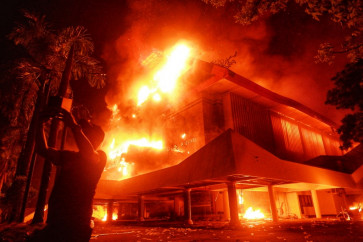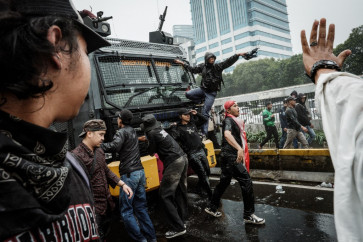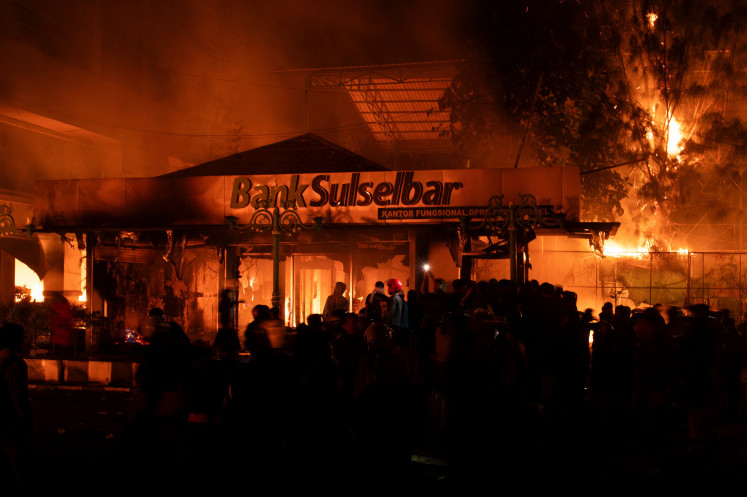Popular Reads
Top Results
Can't find what you're looking for?
View all search resultsPopular Reads
Top Results
Can't find what you're looking for?
View all search resultsRewriting the story of 1965 tragedy
Forty-eight years ago on Oct
Change text size
Gift Premium Articles
to Anyone
F
orty-eight years ago on Oct. 1, 1965, the Indonesian military under the leadership of Soeharto launched its long anticipated attack against the now defunct Indonesian Communist Party (PKI). This attack was aimed at seizing state power and sparked one of the 20th century's worst genocides. To this day the perpetrators of this violence continue to enjoy complete impunity for their actions.
This, however, is not the story that has been told for the last 48 years. We are instead told the story of the Sept. 30 Movement's coup attempt and of a people driven wild by blood lust. We are not told the story of Soeharto's own effective seizure of state power and the manner in which the military meticulously orchestrated and implemented the genocide that followed.
One of the big problems in breaking through official stories surrounding Oct. 1 has been proving the military's intention to launch a coordinated campaign of murder and the lack of hard evidence pinning the military to the killings. The discovery of a 'death map' and detailed chronology of the killings prepared by the Indonesian military, along with over 3,000 pages of classified documents relating to the role of the Indonesian military in initiating and implementing the killings in Aceh province provides us with this evidence.
Until now, the only announcement known to have been transmitted by the military leadership on Oct. 1 was a national radio broadcast made by Soeharto at 9 p.m. on Oct. 1. Through this broadcast Soeharto announced that he had 'temporarily seized the leadership of the Armed Forces' and was working together with 'the Armed Forces, Indonesian Navy and Police Force' to 'annihilate the counter revolutionary actions that have been carried out by that which calls itself the 'Sept. 30 Movement''.
The foolhardy actions of the Sept. 30 Movement were used, as Canadian academic John Roosa has masterfully explained, as the 'pretext' for the military's attack against the PKI. The story of the Sept. 30 Movement has also been used as a cover for the military's own actions on Oct. 1. 'We have the situation both in the capital and in the regions under our control,' Soeharto explained through the same radio broadcast, though it is only now that the significance of this statement is becoming apparent.
Soeharto's coordination of the national military leadership on Oct. 1 began long before his 9 p.m. announcement and was much more extensive than it has previously been possible to demonstrate. During the morning of Oct. 1, the official military chronology records, newly self-appointed military commander Soeharto sent a telegram through internal military wires to declare; 'There has been a coup under the leadership of Lt. Col. Untung', leader of the Sept. 30 Movement.
________________
An official apology will be important step toward demonstrating the Indonesian state's seriousness about drawing a line under the dark legacy of the New Order era.
This announcement was proceeded by the Sept. 30 Movement's own announcement, and was intended to establish the now infamous Indonesian Revolution Council, the first point at which the Sept. 30 Movement could be considered to be a 'coup movement', and demonstrates the offensive nature of the military's campaign. Soeharto's announcement was received by the Inter-Regional Military Commander for Sumatra, Mokoginta, who dutifully passed it on to those under his command. 'Remain calm and at your positions...', Mokoginta explained, 'and await [my] orders and instructions'.
These instructions would come at midnight on Oct. 1, when Mokoginta issued a public speech in Medan where he declared; 'it is ordered that all members of the Armed Forces resolutely and completely annihilate this counter-revolution and all acts of treason to the roots...' All members of the armed forces where meanwhile ordered to 'adhere only to the Decree, Command, instructions and message of Sukarno, as channelled via the temporary leader of the Armed Forces, Maj. Gen. Soeharto.' These instructions were explicitly insubordinate since Sukarno had issued an order at 1.30 p.m. demanding that Soeharto stand down as temporary Commander of the Armed Forces; an order that Sukarno repeated moments before Mokoginta's midnight announcement.
Soeharto and Mokoginta's directive to 'annihilate' the Sept. 30 Movement was not hyperbolic rhetoric. The military leadership was establishing an 'aspiration program' to perpetrate mass harm against its political rival the PKI and intended to mobilize the state and society to this end.
Over the next couple of days, meetings were held throughout the country to coordinate and consolidate this intention and to subordinate civilian government to the military's own command structures. On Oct. 4 this intention was made explicit when a document signed by the Aceh military commander announced; 'It is mandatory for the people to assist in every attempt to completely annihilate the counter-revolutionary Sept. 30 Movement.' The military was ordering civilians to kill other civilians.
Two days later on Oct. 7 the violence began. Beginning as military sponsored demonstrations before progressing to the burning down of offices, people 'disappearing' associated with the PKI and dumping of corpses in the street, the first phase of the genocide is best understood as a pogrom perpetrated in a context in which civilians were explicitly being ordered to assist the military to 'annihilate' anyone associated with the PKI. During this time many PKI members or those associated with the organization were 'arrested' by civilians or death squads before being 'handed over' to be held in military jails. Many PKI members and their families willingly surrendered themselves to the military during this period in order to escape the violence on the streets in the hope that they would at least be protected by the force of the law once they were in prison.
Approximately 10 days later the military intensified its attack, and the full-scale systematic murder of anyone associated with the PKI began. During this second phase the military openly participated in the violence, beginning by releasing small groups of prisoners into the arms of waiting death squads, before directly transporting truckloads of prisoners to killing sites, where prisoners were often forced to dig their own graves before having their throats slit or being shot, either directly by the military or by executioners brought in for
this purpose.
It is in this manner that approximately one million Indonesians were murdered by the Indonesian military as the international community looked on. This violence was not spontaneous, rather highly organized and documented. Over 2,000 public killings are recorded by the military's 'death map' and chronology for Aceh province alone.
Government documents record the establishment of death squads and pledge the state's 'full support' and material assistance for their activities. A death list from North Sumatra records the transfer of prisoners from military run jails to members of the Komando Aksi death squad, who proceeded to transport the prisoners to killing sites to be murdered. It is this story that must now be told.
Momentum is currently growing around the need for an historical reckoning of the Indonesian genocide. The release on Sept. 30 of Joshua Oppenheimer's groundbreaking film The Act of Killing for free download in Indonesia can only continue and accelerate this process.
An official apology by the Indonesian government will be important step toward demonstrating the Indonesian state's seriousness about drawing a line under the dark legacy of the New Order era. True reconciliation must be accompanied by a rewriting of official narratives surrounding the killings. We can begin by rewriting the story of Oct. 1.
___________________
The writer is a PhD student of the School of Historical and Philosophical Studies at the University of Melbourne.










